Easily Insert Pages in Your Excel Sheets with These Tips

In today's fast-paced business environment, the ability to organize and manage data efficiently is crucial. Microsoft Excel remains one of the most utilized tools for data analysis and organization due to its versatility and widespread usage. A lesser-known but extremely useful feature is the ability to insert pages within your Excel sheets, allowing you to keep different types of data organized, secure, and easy to navigate. Here are some detailed tips on how you can leverage this functionality to enhance your productivity.
Understanding Excel Page Breaks

Before delving into how to insert pages, it’s important to understand page breaks in Excel. These are lines that indicate where one page ends and another begins on a printed spreadsheet:
- Automatic Page Breaks: Excel automatically inserts these based on the paper size, margins, scaling, and other print settings.
- Manual Page Breaks: Users can manually set these to control where each page should start.
Learning how to manage both types of page breaks can significantly improve your document's readability and presentation.
How to Insert Manual Page Breaks

To insert a manual page break in Excel, follow these steps:
- Select the row or column where you want the new page to begin.
- Go to the 'Page Layout' tab on the Ribbon.
- Click on 'Breaks' and choose either 'Insert Page Break' for the selected row or column.
This method gives you precise control over pagination. Here are some considerations:
- Ensure that the selected row or column is below or to the right of where you want the break to occur.
- The new page break will be visible in Page Break Preview and print preview modes.
💡 Note: Manual page breaks can disrupt your data flow if not properly managed. Ensure you review your entire spreadsheet layout after inserting them.
Automatic Page Breaks Management

Excel’s automatic page breaks are there to guide you, but they don't always align with your needs. Here's how to adjust them:
- Switch to the 'Page Break Preview' view by going to the 'View' tab and selecting 'Page Break Preview'.
- Here, you can click and drag the blue lines that represent automatic page breaks to manually adjust where pages should split.
Managing automatic page breaks involves:
- Adjusting margins, scaling, or orientation in the 'Page Layout' tab to influence automatic page breaks.
- Revisiting your data's layout and structure to ensure content fits logically into pages.
Printing and Page Setup

When setting up your spreadsheet for printing:
- Access the 'Page Layout' tab and review your settings for 'Orientation', 'Paper Size', and 'Scaling'.
- Use 'Print Preview' to check how your manual page breaks will appear on paper.
Scaling: Scaling allows you to fit your data onto one or several pages, which can be particularly helpful with large datasets:
| Scaling Option | Description |
|---|---|
| Adjust to | Changes the size of your printout to fit a percentage of the page size. |
| Fit to | Forces the printout to fit across a specified number of pages wide and tall. |

✅ Note: Over-scaling can make text unreadable, so find a balance that maintains data integrity.
Keeping Your Work Organized

Here are some best practices for managing pages in Excel:
- Use Page Breaks for Reports: If you regularly generate reports, set permanent page breaks to ensure consistent formatting each time you update the data.
- Data Integrity: Ensure that related data is not split across pages accidentally, which can lead to confusion or misinterpretation.
- Print Area: Define a print area if you only need to print specific parts of your workbook to avoid unnecessary page breaks.
In summary, mastering the use of page breaks and optimizing your printing settings in Excel can significantly improve the readability and professional appearance of your spreadsheets. It's about finding the right balance between the need for organization and maintaining data integrity. Implementing these tips will not only streamline your workflow but also make your data presentations more accessible and engaging.
How do I know where automatic page breaks will occur?

+
Go to ‘Page Break Preview’ view to see where automatic page breaks are set. You can then adjust them as needed.
Can I remove a manual page break?

+
Yes, navigate to the ‘Page Layout’ tab, click ‘Breaks’, and choose ‘Remove Page Break’. Alternatively, drag the page break line in ‘Page Break Preview’ to reset it.
What should I do if my spreadsheet doesn’t fit on one page?

+
Consider adjusting the scaling or using fit-to-page options to ensure your data fits. Alternatively, split the data across multiple pages using page breaks for a more organized presentation.
Is it possible to print a specific area of my Excel sheet?

+
Absolutely, select the area you wish to print, go to ‘Page Layout’, and set the ‘Print Area’. This limits printing to only that selection.
Can I preview how my document will look when printed?

+
Yes, use the ‘Print Preview’ function in Excel to see how your pages will be arranged and formatted on paper before printing.